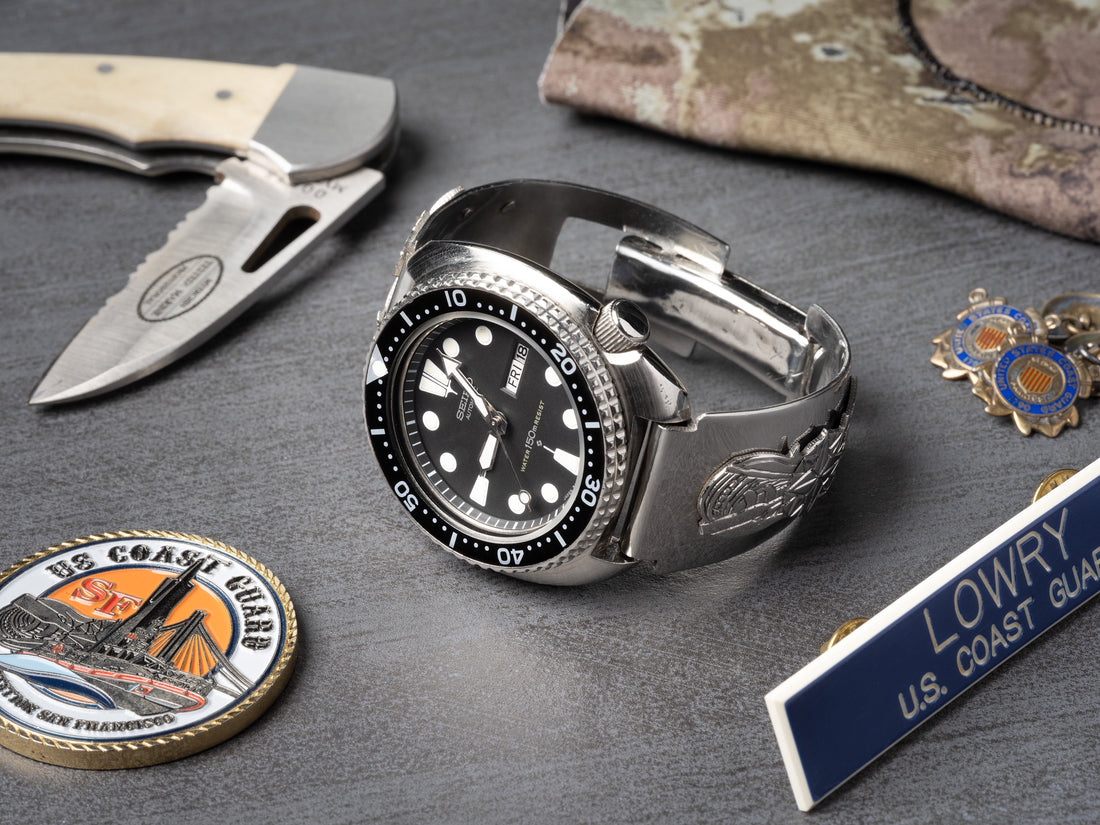One Of History’s Most Important Diving & Military Watches Was Also One Of The Most Attainable
By Benjamin Lowry
At W.O.E., we are vehemently brand agnostic. However, certain brands and watches have a habit of popping up again and again in relation to our community. Who are we to argue with the influence of Sketchy Breitling unit watches or Tudors of Espionage (T.O.E.)? As we often say, we don’t make the rules. W.O.E. himself has a habit of getting sentimental about watches including his custom black Tudor Pelagos FXD, the Jordanian Breitling that started this whole thing, and, of course, the Arabic Seiko (AKA the Seik-W.O.E.).

A USMC Marine Combatant Diver wears a 6309 in 1994. (Photo Credit: US National Archive)
That’s all fine and good for him, but for me, a former Coastie and commercial diver, there is another watch in Seiko’s vintage catalog that is even more meaningful: the 6309, or “Turtle” as it's known to many military members. Backed by impressive military history, a utilitarian design format, widespread adoption in our community, and a more attainable price point compared to other icons in the world of undersea timekeeping, the 6309 is among the most important diving and military watches of all time, full stop. I would even go as far as to say it is the most iconic Watches of Espionage watch of the last five decades, issued to and worn by SEALs, Pararescuemen, Special Forces, and others.
The 6309’s Military Legacy

In the late 1970s, SEAL Teams transitioned from Tudor Submariners (left) to the Seiko 6309 (right). (Photo Credit: Dave Hall)
Released in 1976 and following in the footsteps of Seiko’s 6105 “Willard” models, the 6309 caught on almost immediately with the military. Before Seiko, the US Military of the 1960s and 70s purchased and issued the also legendary Tudor Submariner for its divers and amphibious special operators including Navy SEALs. However, with price points for Rolex and even Tudor watches ascending beyond the meager means of military procurement channels, many SEAL Teams and other SpecOps units adopted the less expensive but equally capable Seiko.

Tim Ryan, a legendary US Air Force Pararescueman (PJ) wears a Seiko 6309 during dive training.
Not limited to official issue, the 6309 was also commonly purchased by military members at the local PX or Navy Exchange. In past profiles of special operators, which are extensive at this point, the 6309 is easily the most commonly encountered mechanical dive watch in the late 70s and 80s. When US Navy SEAL Dave Hall shook hands with Scout Sniper legend Gunny Carlos Hathcock after completing sniper school, a Seiko Turtle was on his wrist. When Jose Gordon was a young Army Ranger assisting the Contras in their fight against communism in Nicaragua in the 1980s, he wore a Seiko 6309. In more recent years, Kyle Defoor—who would go on to serve with SEAL Team Six or DEVGRU—wore a 6309 formerly belonging to SEAL legend Rudy Boesch, again demonstrating the decades-long relationship between this watch and the SpecOps community.

One of the two “Dadaepo Frogmen” captured by the South Korean Army in 1983 wore a Seiko 6309. If that ain’t ubiquitous, I don’t know what is.
The Turtle’s reach was not limited to the United States, the military, or even the free world, with the 6309 also being commonly spotted on international forces of the day, countless recreational divers, as well as North Korean frogmen doing their very best to conduct maritime espionage operations off the coast South Korea. When it comes to military legitimacy, the 6309 is as real as it gets. Again, we don’t make the rules.
An Attainable Yet Capable Mechanical Diver From Japan

A US Navy SEAL wearing a 6309 in 1987. (Photo Credit: US National Archives)
While the 6309’s brick shithouse-like reputation and legible design were also key components of its success, its single biggest selling proposition was value, coming in at a much more attainable price point compared to Swiss-made mechanical dive watches of the era. A US Seiko retail pricing guide from the Fall of 1977 lists the DE095, the 6309’s official reference at the time, for $155.

No matter how you slice it, the 6309 did the same job for less money.
While that equates to somewhere around $793 today, the Seiko represented a relative bargain, with a Tudor Submariner coming in at $295 suggested retail price the same year, which is something like $1,525 today, also known as double the price. For argument’s sake, a Rolex Submariner Date would have set you back $585 in 1977 or $3,024 in 2024 dollars. Surprisingly, the Turtle’s modern equivalent, the SRPE93, is relatively less expensive than its ancestor at $495.

US Navy SEAL Dave Hall shakes hands with Marine Scout Sniper Carlos Hathcock while wearing a Seiko Turtle. (Photo Credit: Dave Hall)
In military settings, the almighty dollar is often king and the cheapest thing that works is typically the mantra for selecting gear. When Seiko’s 6309 hit the scene, the days were quickly numbered for Swiss watches in military settings, with the 6309 and later Seiko references seeing widespread use in the amphibious military community through the advent of G-Shocks and other capable digital watches in the early 1980s. In many ways, the Seiko 6309 served as the last great mechanical dive watch in broader military circulation, a proud title by any standard.
Design & Specs

A Navy Diver wears a 6309 on an Olongapo bracelet in 1988. (Photo Credit: US National Archives)
No matter how attractive the price, a dive watch trusted by a Navy Diver, SEAL, or US Air Force Pararescueman has to get the job done first and foremost, and that’s exactly what the 6309 did. Measuring somewhere around 44mm across its cushion case and only 45mm in length, the Turtle mastered the challenging task of being large enough for excellent legibility while also fitting well on the vast majority of wrists. A recessed crown at four o’clock was also unobtrusive and worked well with myriad diving suits and for physical training, which SEALs and other special operators seem to enjoy.

The author’s 6309 and other ephemera from his USCG service. (Photo Credit: James Rupley/W.O.E.)
The dial and hands, whose basic design still permeates Seiko’s diving range, were legible day and night, a product of Seiko’s legendary luminescent material. The bezel was tall, with a prominent double row of teeth that could be easily operated with gloves, and also offered fine adjustment with a 60-click bidirectional system in stark contrast to Rolex and Tudor’s friction-fit bezels of the era. The rubber strap was comfortable and long enough for virtually any wearing scenario.

A 1970s 6309 issued to SEAL Legend Rudy Boesch and currently owned by Kyle Defoor, a veteran of SEAL Team Six. (Photo Credit: Kyle Defoor)
These were all great features to have, but the 6309 movement powering the Turtle was the star of the show. While it lacked hacking—a feature relegated to the JDM 6306—the 6309 earned a reputation for being unstoppable, with many running well for decades without even the slightest hint of a service. Accuracy was hit-and-miss but good enough for most operators in the pre-digital age, and the sheer volume of solid vintage 6309s on the market speaks to the watch’s rugged build.
My 6309 From August Of 1980

The author’s 1980 6309-7040. (Photo Credit: Benjamin Lowry)
Despite the 6309’s heritage and considerable laurels in the arena of dive watches, much of my fondness for the watch stems from my experiences wearing mine, a birthday gift from my father—who is also a dedicated watch enthusiast—back in 2010, shortly before I joined the Coast Guard.
I had a limited understanding of how to wear a vintage watch at the time, and I wore it like it was brand new. 30 years old and likely never serviced beyond some aggressive case polishing, the timekeeping sucked and the lume was toast. Still, the rugged old diver provided so much to like, serving me well over four years at Coast Guard Station San Francisco including no shortage of boat ops. At some point, I became wise enough to get the watch serviced and pressure-tested, which was smart considering my transition into commercial diving.

It’s not easy to be as cool as a SEAL wearing a M81 boonie hat in 1987, but a Seiko 6309 is a start. (Photo Credit: US National Archive)
I wore the beat-up old Turtle on several scuba and hardhat dives, once again using the watch as the tool it was intended to be when the model was introduced in 1976. Now 44 years old, and despite a collection that now includes watches like the Tudor Pelagos 39, the 6309 still finds its way into the rotation. A watch is never just a watch, and for me, this old Turtle symbolizes not only my own personal history with the military and diving but also a broader decades-long heritage with some of the military’s most elite maritime operators.
If you’re a member of the greater W.O.E. community and appreciate dive watches and you haven’t taken the proverbial plunge with a vintage 6309, you’re doing it wrong. Luckily, with decent vintage examples still going for between $500 and $1,000 in many cases, the 6309 is a great opportunity to get into what I would call not only the real Seik-W.O.E but perhaps also the most W.O.E. watch you can get.
If you enjoyed this article, please consider signing up for our weekly free newsletter for further updates HERE.
Read Next: CIA Officer’s Love Affair with the Arabic Seiko









36 comments
I remember having this watch. Lost it when my pants were cut off by paramedics, after an accident. Mine had a dual language setting to get the Day to French abbreviation. Great article and history.
Thanks for the great article. I purchased the 6309 in December of 1985 after graduating infantry basic at Ft. Benning. It replaced the green plastic Timex Military watch that was purchased and worn during basic. These were the first two watches I owned.
The stem in my 6309 [circa 1980] needs to be replaced. Sieko America says the parts are no longer available.
Any chance you know where I could get it repaired?
Have my 6306 JDM from my birth year of 1976, the first year it was issued. Came just served in really good condition from a reputable dealer for $1100. Steal of a watch
Thank you for an amazing article on one of the all-time greatest watches and one that readily exemplifies the Coast Guard’s “Semper Paratus.” I was curious if you could share more details on the custom metal bracelet in the picture with your name badge? That is exactly the style I would like for mine, but I don’t know what they are called.